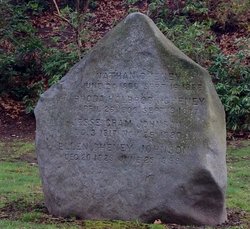assage found in James L Parr's book "Framingham Legends & Lore":
Sherborn Reformatory
The facility that is today known as the Massachusetts Correctional Institute–Framingham began its life in a different town with a different name. Originally known as the Massachusetts Reformatory Prison for Women, it was established in the town of Sherborn in 1877. When the town of Framingham annexed 565 acres of north Sherborn in 1924, it also acquired the women's prison and its colorful history.
The Sherborn Reformatory was the first women's prison in the country, begun by social reformers with the intent of actually changing the lives of its inmates rather than merely incarcerating them. To accomplish this mission, the women were put to work on the four-hundred-acre farm that surrounded the imposing brick prison building. A variety of vegetables and grain crops were grown, and pigs, cows, sheep and poultry were also raised. For a time, the inmates raised silkworms, which spun their cocoons in the 128 mulberry trees planted expressly for that purpose. A shirt-making industry was also operated on the grounds. Receipts from the sale of the prison's products were used to cover operating expenses.
Another crucial component of the inmates' reformation was the grading system used to encourage and reward hard work and good behavior. Upon entering the institution, inmates were assigned a grade, or division, from one to four. Inmates in the higher divisions were given more comfortable rooms and privileges, such as letter writing and tea taking. Some inmates in Division 4 were sent out to work as domestics in local homes. A point system, much like a report card, was used to keep track of an inmate's progress, allowing her to gain more privileges as she moved up through the divisions.
One of the first superintendents of the reformatory was Clara Barton, founder of the American Red Cross. Miss Barton had been deeply immersed in her Red Cross work in the spring of 1883 when the governor of Massachusetts, retired General Benjamin Butler, asked her to take over the superintendent's position. Although she was reluctant to leave her Red Cross mission, Barton felt a fierce loyalty to Butler, who had strongly supported her as she ministered to the wounded and dying on the battlefields during the Civil War. After taking a tour of the facility, she agreed to take the position, but only for six months. Although the facility had been open for only six years at the time Barton took over, it had already earned a national reputation as a model for reform. Clara Barton's short stewardship only reinforced that reputation.
Her tenure there was marked by kindness and empathy toward the women, many of whom she viewed not as criminals but as victims of poverty, alcohol and the social double standards of the time. She treated them with a respect and human dignity they had never experienced before. Her reputation as the "Angel of the Battlefield" during the Civil War inspired awe in the prisoners who met her as she walked the hallways and gave talks in the chapel. Upon their release, many inmates tearfully promised her they would turn their lives around. Barton also made improvements to the prison's educational, governmental and business systems. She stayed two months longer than she had agreed to, returning to the American Red Cross in early 1884.
Barton was succeeded by Mrs. Ellen Johnson, who held the post for fifteen years until her death in 1899. Despite several unfortunate incidents over the years, including a series of prisoner riots in 1888, Johnson ran the reformatory with efficiency and compassion and is remembered as one of the most successful and innovative reformers of the nineteenth century.
assage found in James L Parr's book "Framingham Legends & Lore":
Sherborn Reformatory
The facility that is today known as the Massachusetts Correctional Institute–Framingham began its life in a different town with a different name. Originally known as the Massachusetts Reformatory Prison for Women, it was established in the town of Sherborn in 1877. When the town of Framingham annexed 565 acres of north Sherborn in 1924, it also acquired the women's prison and its colorful history.
The Sherborn Reformatory was the first women's prison in the country, begun by social reformers with the intent of actually changing the lives of its inmates rather than merely incarcerating them. To accomplish this mission, the women were put to work on the four-hundred-acre farm that surrounded the imposing brick prison building. A variety of vegetables and grain crops were grown, and pigs, cows, sheep and poultry were also raised. For a time, the inmates raised silkworms, which spun their cocoons in the 128 mulberry trees planted expressly for that purpose. A shirt-making industry was also operated on the grounds. Receipts from the sale of the prison's products were used to cover operating expenses.
Another crucial component of the inmates' reformation was the grading system used to encourage and reward hard work and good behavior. Upon entering the institution, inmates were assigned a grade, or division, from one to four. Inmates in the higher divisions were given more comfortable rooms and privileges, such as letter writing and tea taking. Some inmates in Division 4 were sent out to work as domestics in local homes. A point system, much like a report card, was used to keep track of an inmate's progress, allowing her to gain more privileges as she moved up through the divisions.
One of the first superintendents of the reformatory was Clara Barton, founder of the American Red Cross. Miss Barton had been deeply immersed in her Red Cross work in the spring of 1883 when the governor of Massachusetts, retired General Benjamin Butler, asked her to take over the superintendent's position. Although she was reluctant to leave her Red Cross mission, Barton felt a fierce loyalty to Butler, who had strongly supported her as she ministered to the wounded and dying on the battlefields during the Civil War. After taking a tour of the facility, she agreed to take the position, but only for six months. Although the facility had been open for only six years at the time Barton took over, it had already earned a national reputation as a model for reform. Clara Barton's short stewardship only reinforced that reputation.
Her tenure there was marked by kindness and empathy toward the women, many of whom she viewed not as criminals but as victims of poverty, alcohol and the social double standards of the time. She treated them with a respect and human dignity they had never experienced before. Her reputation as the "Angel of the Battlefield" during the Civil War inspired awe in the prisoners who met her as she walked the hallways and gave talks in the chapel. Upon their release, many inmates tearfully promised her they would turn their lives around. Barton also made improvements to the prison's educational, governmental and business systems. She stayed two months longer than she had agreed to, returning to the American Red Cross in early 1884.
Barton was succeeded by Mrs. Ellen Johnson, who held the post for fifteen years until her death in 1899. Despite several unfortunate incidents over the years, including a series of prisoner riots in 1888, Johnson ran the reformatory with efficiency and compassion and is remembered as one of the most successful and innovative reformers of the nineteenth century.
Family Members
Advertisement
Explore more
Sponsored by Ancestry
Advertisement





